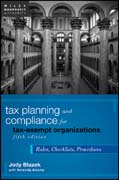
Tax planning and compliance for tax-exempt organizations: rules, checklists, procedures
Blazek, Jody
An essential, timesaving guide for accountants, lawyers, nonprofit executivesand directors, consultants, and volunteers This book is an indispensable guide to navigating the complex maze of nonprofit tax rules and regulations. A clear and fully cited description of the requirements for the various categories of tax-exempt entities from public charities, private foundations, civic associations, business leagues, and social clubs to title-holding companies and governmental entities can be found. Practical guidance on potential for income tax on revenue-producing enterprises along with explanations of many exceptions to taxability is provided. Issues raised by Internet activity, advertising, publishing, providing services, and much more are explained. This useful guide covers the many significant issues facing nonprofit organizations, including compensation and possible private inurement, affiliation, separations and mergers, donor disclosures, lobbying and electioneering, and employment taxes. Offers a supplemental, annual update to keep subscribers current on relevant changes in IRS forms, requirements, and related tax procedures Includes easy-to-use checklists highlighting such critical concerns as tax-exempt eligibility, reporting to the IRS, and comprehensive tax compliance issues Features a variety of sample documents for private foundations, including penalty abatement requests and sharing space agreements Provides helpful practice aids, such as a comparison of the differences between public and private charities, charts reflecting lobbying limits for different types of entities, and listings of rulings and cases that illustrate permissible activity for each type of organizations compared to impermissible activity Filled with practical tips and suggestions for handling such critical situations as preparing for and surviving an IRS examination, Tax Planning and Compliance for Tax-Exempt Organizations, Fifth Edition provides guidance for the significant issues facing nonprofit organizations. INDICE: About The Author Preface Acknowledgments Exhibits Part One Qualifications Of Tax-Exempt Organizations Chapter One Distinguishing CharacteristicsOf Tax-Exempt Organizations 1.1 Differences Between Exempt And Nonexempt Organizations 1.2 Nomenclature 1.3 Ownership And Control 1.4 Role Of The Internal Revenue Service 1.5 Suitability As An Exempt Organization 1.6 Start-Up Tax AndFinancial Considerations 1.7 Choosing The Best Form Of Organization Chapter Two Qualifying Under Irc 501(C)(3) 2.1 Organizational Test 2.2 Operational TestChapter Three Religious Organizations 3.1 Types Of Religious Organizations 3.3 Religious Orders 3.4 Religious And Apostolic Associations Chapter Four Charitable Organizations 4.1 Relief Of The Poor 4.2 Promotion Of Social Welfare 4.3Lessening The Burdens Of Government 4.4 Advancement Of Religion 4.5 Advancement Of Education And Science 4.6 Promotion Of Health 4.7 Cooperative Hospital Service Organizations Chapter Five Educational, Scientific, And Literary Purposes And Prevention Of Cruelty To Children And Animals 5.1 Educational Purposes 5.2 Literary Purposes 5.3 Scientific Purposes 5.4 Testing For Public Safety 5.5 Fostering National Or International Amateur Sports Competition (But Only If No Part Of Its Activities Involves The Provision Of Athletic Facilities Or Equipment) 5.6 Prevention Of Cruelty To Children Or Animals Chapter Six Civic Leagues And Local Associations Of Employees: 501(C)(4) 6.1 Comparison Of (C)(3) And (C)(4) Organizations 6.2 Qualifying And Nonqualifying Civic Organizations 6.3 Local Associations Of Employees 6.4 Neighborhood And Homeowners Associations 6.5 Disclosures Of Nondeductibility Chapter Seven Labor, Agricultural, And Horticultural Organizations: 501(C)(5) 7.1 Labor Unions 7.2 Agricultural Groups7.3 Horticultural Groups 7.4 Disclosures Of Nondeductibility Chapter Eight Business Leagues: 501(C)(6) 8.1 Basic Characteristics 8.2 Meaning Of Common Business Interest 8.3 Line Of Business 8.4 Rendering Services For Members 8.5 Sources Of Revenue 8.6 Membership Categories 8.7 Member Inurement 8.8 Chambers Of Commerce And Boards Of Trade 8.9 Comparison To 501(C)(5) 8.10 Recognition Of Exempt Status 8.11 Formation Of A Related Charitable Organization 8.12 Disclosures For Lobbying And Nondeductibility Chapter Nine Social Clubs: 501(C)(7) 9.1Organizational Requirements And Characteristics 9.2 Member Inurement Prohibited 9.3 Membership Requirements 9.4 Revenue Tests 9.5 Unrelated Business IncomeTax 9.6 Filing And Disclosure Requirements Chapter Ten Instrumentalities Of Government And Title-Holding Corporations 10.1 501(C)(1) Instrumentalities Of The United States 10.2 Governmental Units 10.3 Qualifying For 501(C)(3) Status10.4 501(C)(2) Title-Holding Corporations 10.5 501(C)(25) Title-Holding Corporations Chapter Eleven Public Charities 11.1 Distinctions Between Public And Private Charities 11.2 Inherently Public Activity And Broad Public Support: 509(A)(1) 11.3 Community Foundations
- ISBN: 978-0-470-90344-5
- Editorial: John Wiley & Sons
- Encuadernacion: Cartoné
- Páginas: 816
- Fecha Publicación: 15/02/2012
- Nº Volúmenes: 1
- Idioma: Inglés
